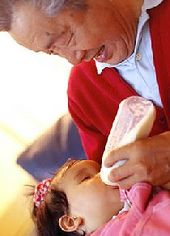
The scientists, whose study appears in the latest issue of the journal Current Biology, urged more research into the potential effects of bisphenol A, a chemical long criticized by environmentalists as being a hormone disruptor that could cause defects in embryos.
The defects observed in tests on mice, had they occurred in humans, could lead to miscarriages or mental retardation such as Down Syndrome - and they seem to be caused at what were considered to be low levels of exposure, the researchers reported.
The discovery was made by accident, reported Associate Professor Patricia Hunt of Case Western Reserve University in Ohio and colleagues. Her team first noted a higher than normal increase in abnormalities in developing egg cells in female mice.
"We were looking at the processes as cells start to undergo division," Hunt, a geneticist, said in an interview. "The chromosomes are supposed to line up in an orderly fashion so they can divide in an orderly fashion.
"What we saw was a tremendous increase in the number of cells in which the alignment of chromosomes in the cells were not orderly at all - they were very disorderly," she said.
In the mice they were studying, this only usually happens 2% of the time; but Hunt's team said 40% of the eggs were developing these problems. They spent weeks looking for the cause.
"Nothing turned up. But ... I noticed that the plastic cages looked kind of the worst for wear," Hunt said. It turned out that a harsh detergent used to clean the cages had broken down the plastic, releasing bisphenol A.
Hunt's team then deliberately exposed the mice to small amounts of bisphenol A for short periods of time, and found the abnormalities increased again.
Many labs are studying the effects of bisphenol A and other chemicals that act as endocrine disruptors - affecting the actions of hormones in the body. Some scientists fear that developing fetuses and young children are especially vulnerable to these effects.
"Pat Hunt hasn't shown damage in fetuses yet, but it has to be a subject of concern," said Professor Fred vom Saal, an expert on the effects of toxins on reproduction at the University of Missouri in Columbia.
"Bisphenol A is one of the most commonly used plastic materials in food containers, in beverage containers. This is a ubiquitous chemical ... at least in the developed world. It is one of the top 50 chemicals in production," he said.
Hunt, who studies the effects of aging on egg cells and fertility, said she was not even looking for chemical influences. "That's one of the things I think makes our study unusual," she said.
While the study was not aimed at analyzing the the effects of bisphenol A in humans, Hunt said there is reason to believe they would be similar. The changes in the mice cause aneuploidy - a misalignment of the chromosomes that is seen in human birth defects and miscarriages.
"You don't wait to prove that it does that in people before you take some regulatory action," Vom Saal agreed, adding that he hoped research agencies move to fund more studies on the effects of bisphenol A.
"We are talking about these mice essentially drinking out of old baby bottles," Vom Saal said - noting that hard plastic containers like bottles start leaching bisphenol A when they begin to look cracked or etched. He also urged the chemical industry to make more plastic products that do not contain bisphenol A.
Previous studies and scientific risk assessments had suggested bisphenol A presented a very small potential risk. Plastics manufacturers have vehemently defended the use of the chemical, used widely in making polycarbonate plastic.
Some of the funding for the study came from the industry-supported American Chemistry Council via the U.S. National Institute for Environmental Health Sciences.



Comment: Despite FDA concern, American Chemistry Council insists Bisphenol A is safe for everyone: For more information on the negative health effects of Bisphenol A or BPA read: The Real Story Behind Bisphenol A
Listed below are several articles that clearly depict the toxicity of BPA and it's effects on the human body.
New Study Confirms Bisphenol A Found in Plastic is Linked to Heart Disease
BPA Study Points To Intestine Damage
BPA Linked To Male Sexual Dysfunction
Bisphenol A Linked to Metabolic Syndrome in Humans
Plastics chemical alters female brains - Research renews debate over the toxicity of bisphenol A, a plastics chemical found in humans
Prenatal BPA Exposure Linked to Behavioral Issues
Bisphenol A exposure dangerous for human heart and reproduction
BPA Should Be Avoided, Federal Official Says